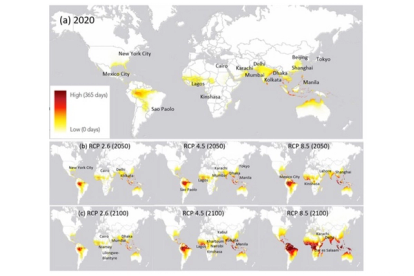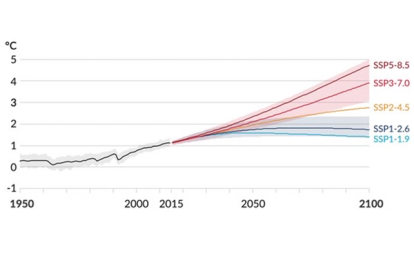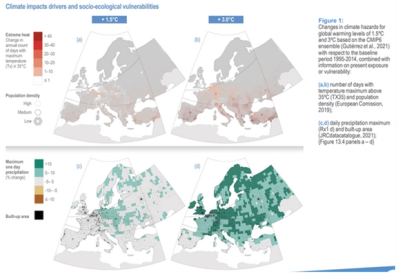
Key highlights from the IPCC Impacts, Adaptation and Vulnerability report
- Post Date
- 11 February 2023
- Read Time
- 9 minutes

This blog post is the second in a four-part series unpacking the key pieces of information from the IPCC AR6 reports. Part one - The latest climate science from the IPCC. Part three - How to keep global warming to within 'safe levels'.
The Intergovernmental Panel on Climate Change (IPCC) produces a set of major reports every seven years summarising the latest climate science and its implications for human society. It is currently in its sixth assessment report cycle (AR6).
In February 2022, the IPCC released the second report in the series, AR6 Climate Change 2022: Impacts, Adaptation and Vulnerability. This report examines climate change impacts so far and how it will impact the world in the future. A key dimension to the report is how humans can adapt to climate change.
Given the intervals between reporting cycles, this will most likely be the last IPCC Assessment Report before the 1.5°C temperature threshold is breached.
Key highlights from the report:
- With high confidence, the report states that approximately 3.3-3.6 billion people “live in contexts that are highly vulnerable to climate change”.
- Approximately 50-75% of the global population could be exposed to periods of “life threatening climatic conditions” due to extreme heat and humidity by 2100. This can occur when humidity is so high that sweating ceases to cool the human body.
- Cities in tropics are particularly at risk from rising temperatures and higher humidity. As a result they could be “subject to twice the levels of heat stress compared to their rural surroundings under all RCP scenarios by 2050”. This includes mega cities such as São Paulo (22m), Dhaka (22m), Mumbai (21m), Kolkata (15m), Kinshasa (15m), Lagos (15m), Guangzhou (13m), and Manila (14m).

- “Much of the world’s population, economic activities and critical infrastructure are concentrated near the sea (high confidence), with nearly 11% of the global population, or 896 million people, already living on low-lying coasts directly exposed to interacting climate- and non-climate coastal hazards.”
- By 2050, more than a billion people located in low-lying cities and settlements will be at risk from “coastal-specific climate hazards”, the report says with high confidence. However, it notes that the amount of damage caused will be dependent on future warming levels and socioeconomic scenarios. This means that between $7-14trillion of coastal infrastructure assets will be exposed by 2100, according to the report – affecting sectors including transportation, housing, power production and information technology.
- Increasing weather and climate extremes “have exposed millions of people to acute food insecurity and reduced water security”, with the the most significant impacts observed in parts of Africa, Asia, Central and South American small islands and the Arctic.
- Climate change “will increasingly put pressure on food production and access [to food], especially in vulnerable regions, undermining food security and nutrition”. Both food and water insecurity can be expected to intensify with rising temperatures.
- Climate change and extreme weather events “will significantly increase ill health and premature deaths from the near- to long-term.”
- Where climate change intersects with areas of high vulnerability, it is “contributing to humanitarian crises” and “increasingly driving displacement in all regions, with small island states disproportionately affected”.
- As the planet warms, migration is likely to increase, the report finds. For example, for every 1°C of extra warming, the global risk of involuntary displacement due to flooding increases by 50%.
- Climate change is also expected to reduce water availability. Existing literature linking water insecurity to conflict is limited, but the report says “the large majority acknowledges” that limited water availability can “exacerbate tensions”. For example, in Syria, drought has aggravated existing water and agricultural insecurity – but the report says that “whether drought caused civil unrest in Syria remains highly debated”.
- The report cites analysis which suggests that 2°C warming would increase the probability of “conflict risks” by 13%, due to reduced food and water security, and disruption to lives and livelihoods. This instability can lead to “civil unrest” in some regions, which is often linked to an increase in violence against women, girls and vulnerable groups, the report warns.
- The report compares the levels of risk for species extinction at different temperature levels. “It is likely that the percentage of species at high risk of extinction (median and maximum estimates) will be 9% (max. 14%) at 1.5°C, 10% (max. 18%) at 2°C, 12% (max. 29%) at 3.0°C, 13% (max. 39%) at 4°C and 15% (max. 48%) at 5°C.”
- Indeed, there may be a threshold beyond which the level of extinction precipitates near total system collapse. The report states, “climate change impacts and risks are becoming increasingly complex and more difficult to manage. Multiple climate hazards will occur simultaneously, and multiple climatic and non-climatic risks will interact, resulting in compounding overall risk and risks cascading across sectors and regions. Some responses to climate change result in new impacts and risks (high confidence).”
Perhaps unsurprisingly given the stark conclusions of this mounting body of evidence, more data has emerged of the detrimental impacts of climate change on mental health. Heat is “one of the best-studied aspects of climate change observed to reduce wellbeing”, according to the report. It says that increasing temperatures are linked to higher hospital admissions for mood and behavioural disorders, “experiences of anxiety, depression, and acute stress” and suicide rates. A recent study suggested higher temperatures are reducing people’s average sleep time. Sleep is widely acknowledged to be key to health and wellbeing.
What does the report say about the necessary adaptation?
The report says that, “gaps exist between current levels of adaptation and levels needed to respond to impacts and reduce climate risks”. In other words, climate adaptation is currently insufficient. This is largely due to the focus that has thus far been placed on climate mitigation.
As we are witnessing, climate change is already having a significant impact around the world. Even in the very best case scenario where emissions peak in the next 10 years, it is important to keep in mind that there is a time lag of approximately 10 years between when emissions are released into the atmosphere and the ensuing temperature rise. This is why the various different scenarios look quite similar until the latter half of the 2020s.

- Mortality and morbidity of people and changes in ecosystems due to heat
- Heat and drought stress on crops
- Water scarcity
- Flooding and sea-level rise
Focusing on heat and drought stress on crops, the report says: “Substantive agricultural production losses are projected for most European areas over the 21st century, which will not be offset by gains in Northern Europe (high confidence). While irrigation is an effective adaptation option for agriculture, the ability to adapt using irrigation will be increasingly limited by water availability, especially in response to global warming above 3°C (high confidence).”
The factsheet provides an indication as to the differences between 1.5°C and 3°C for extreme heat and maximum one day precipitation, i.e., the amount of rainfall that can occur in a very short period of time. As can be seen the in the diagram below, a 3°C scenario increases the area prone to experiencing extreme rainfall significantly across Europe.

The factsheet also offers solutions such as: “irrigation, vegetation cover, changes in farming practices, crop and animal species, and shifting planting; [fire and forest management, and agroecology]”.
It also documents key barriers as: “limited resources, lack of private sector and citizens engagement, insufficient mobilisation of finance, lack of political leadership, and low sense of urgency. Most of the adaptation options to the key risks depend on limited water and land resources, creating competition and trade-offs, also with mitigation options and socio-economic developments (high confidence).”
Importantly, the report also discusses residual risks, i.e., risks that cannot be mitigated. It states that, “residual risk can result in losses of habitat and ecosystem services, heat related deaths, crop failures, water rationing during droughts in Southern Europe, and loss of land (medium confidence).”
What does this mean for companies, investors, and individuals?
Firstly, when one is proverbially in a hole, stop digging - so the age-old adage goes. That means all organisations and individuals need to mobilise to cut emissions as soon as possible. They can also support a wider network effect by signalling to others that they are taking pro-active action to cut emissions. Whilst all actions that reduce emissions are good, actions that support systemic changes should be prioritised. For example from a personal perspective, reducing meat consumption is good, explaining to your friends and family why you are doing it and encouraging them to do the same is has an even more powerful network effect. The same could be said for flying, switching to a renewable energy provider, driving less, voting for politicians with ambitious climate polices etc.
For many organisations, one of the easiest and most impactful ways to cut emissions is by switching to a renewable energy provider. For investors, their impact is concentrated in their portfolios, so exploring ways to support investee companies in their net zero transition is key. This is something our net zero specialists can support you with here at SLR.
Looking to the impacts of climate change and how to adapt to them, performing a climate change risk assessment is a sensible first step, followed by embedding effective risk management into existing systems. The ISO14090:2019 Adaptation to Climate Change standard provides a helpful framework for organisations to consider.
At SLR, we recently assessed climate risk under different scenarios for a $450bn pension fund, focusing on their most significant coastal assets. The main surprise for the client being the speed with which risks such as sea-level rise and storm surges could materialise, even in low-emissions scenarios. It is important for organisations to consider that risks may occur in the short to medium term, and need to be planned for today.
For support with climate change risk assessments, climate scenario analysis, developing your organisation’s climate strategy and capacity or responding to the TCFD reporting requirements please contact us.
Recent posts
-

-

Understanding sound flanking: Fire alarm speaker cable conduits in multi-family buildings
by Neil Vyas
View post -
